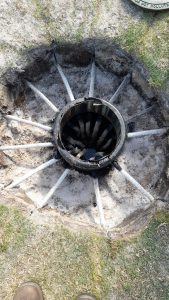Infiltration and permeability
Amber Anderson
- Identify factors influencing infiltration and permeability
- Predict how a soil difference, either management or natural, might impact permeability or infiltration rates
Overview from the NRCS
Watch the video at: https://www.youtube.com/watch?v=vmo0FRAVgkM
As seen in the video or during any rainfall, a raindrop hits the ground with significant force. This force could dislodge the particles, leading to runoff and erosion discussed in the following chapters, or it could enter (infiltrate) and move through the soil (soil permeability or hydraulic conductivity).
Infiltration and percolation are two concepts that describe the rate at which water moves into the soil (infiltration) and through the soil profile, vertically and horizontally (percolation). And permeability explains how well water can move through the porous media or the soil.
Water movement in soil video:
This video shows water movement in soil with contrasting particles or other changing scenarios.
Watch the video at: https://www.youtube.com/watch?v=ego2FkuQwxc
Watch this overview video at: https://youtu.be/XSOWxaW4JG8

Capillary movement is the water movement through the soil profile thanks to adhesivity and cohesion forces. Adhesion forces allow water molecules to stick together, and cohesion describe the attraction force that bonds water to other surrounding particles different from water (eg., soil particles). Based in this principle, PC-Drainage (passive capillary drainage) is a modern technology being implemented in golf courses.
As the picture shows, rope is buried underground all around the main basin. This rope is porous material with a hollow stainless-steel mesh core that transports water to the basin. When the rope is installed, a layer of sand is poured on top, this creates a different texture barrier that makes water percolate deeper faster than laterally, increasing the water captured by the rope. This method is widely used in golf courses because its installation does not require digging deep trenches for conventional pipe, allowing golfers to play right after its installation. Also, the porous media replaces the conventional tile drainage that is easily clogged with fine soil particles, like silt.
- Texture, structure, residue, and crusting influence infiltration or how water move into a soil
- Texture, structure, contrasting particle sizes influence permeability or how water moves through a soil

